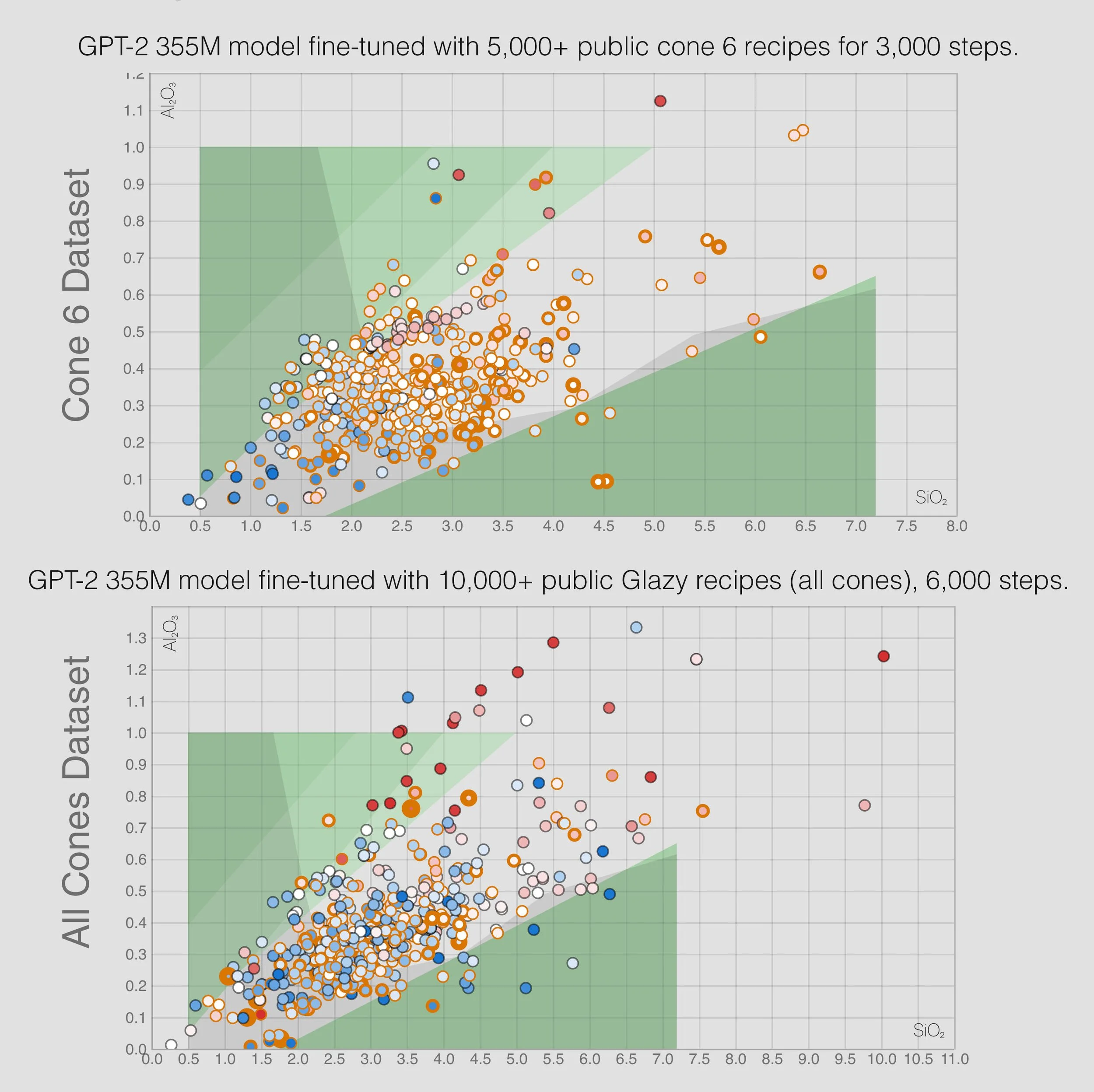GPT-2 Generated Ceramic Recipes
Having been on the GPT-3 API waitlist for months, I finally just decided to fine-tune the older and smaller GPT-2 355M model using over 10,000 public Glazy recipes as training data. Although the loss was still going down after 6,000 steps, I stopped training at that point as I noticed more duplicates being generated and I was afraid of overfitting my relatively small dataset.
As always, Gwern has a wonderful article, GPT-2 Neural Network Poetry. For training I followed Max Woolf's article How To Make Custom AI-Generated Text With GPT-2 and used Max's wonderful Colab Notebook
Sample recipe from training data:
RECIPE: Winokur Yellow INGREDIENT: 53.2000 Potash Feldspar INGREDIENT: 22.9000 Kaolin INGREDIENT: 19.4000 Dolomite INGREDIENT: 4.5000 Whiting INGREDIENT: 16.9000 Zircopax INGREDIENT: 3.5000 Tin Oxide INGREDIENT: 1.4000 Red Iron Oxide
I generated two sets of recipes, one with GPT-2 temperature set at 0.7 and one at 0.9. The results for both sets were surprisingly good: At first glance the recipes seemed "real" with proportional mixes of feldspars, clays, silica, fluxes and colorants/opacifiers. Even the total ingredient amounts added up to a reasonable number, usually in the range of 90-110%. The duplication rate was about 5% for t=0.7 and 4.5% for t=0.9.
Sample generated recipes (removing "RECIPE:" and "INGREDIENT:" tags):
Crawly Elsie's Matte-04 38.0000 EP Kaolin 28.0000 Gerstley Borate 19.0000 G-200 Feldspar 9.0000 Lepidolite 6.0000 Soda Ash 4.0000 Wollastonite Ame-Sosa-Wenkel 38.0000 Nepheline Syenite 29.0000 Silica 12.0000 Colemanite 8.0000 Whiting 6.0000 Dolomite 5.0000 Barium Carbonate 2.0000 Bentonite 1.0000 Rutile 0.7500 Copper Carbonate Amber Celadon 34.0000 Albany slip 20.0000 Custer Feldspar 13.0000 Silica 13.0000 Wollastonite 6.0000 Whiting 3.0000 EP Kaolin 3.0000 Gerstley Borate 3.0000 Rutile 2.0000 Red Iron Oxide Craters 30.0000 Lithium Carbonate 30.0000 Silica 15.0000 Borax 10.0000 Zircopax 10.0000 Kaolin 5.0000 Bentonite 3.0000 Copper Carbonate
Downloads:
Temperature 0.7 Generated Recipes
Temperature 0.9 Generated Recipes
The next step was to load the GPT-2 generated recipes into Glazy in order to see their resulting analyses and visualize them on the Stull Chart. I was surprised to find that, as with "real" glaze recipes, most of these generated recipes fell comfortably within the major Stull regions of Bright, Matte, and Semi-Matte. The set with temperature setting of 0.9 generated more variation.
Generated recipes displayed in the Stull Chart.
Training against a subset of recipes, using only the cone 6 glazes, gave results with lower Silica and Alumina, as well as higher Boron.
Cone 6 generated recipes showing lower Silica & Alumina as well as higher levels of boron.
The obvious next step was to fire some of these "fake" recipes and create real glazes. Rather than randomly testing, I selected a few recipes that looked like they would fire to maturity at my chosen temperature and atmosphere, Orton cone 6 in Oxidation. The results were all quite good, and I uploaded a couple to Glazy:
GPT-2 Yellow Textured
GPT-2 Three's Company
Selected generated recipes fired at Orton cone 6 in Oxidation.
Using Glazy's public data (https://github.com/derekphilipau/glazy-data) I attempted to associate glaze metadata (type, surface, transparency and temperature) with analyses.
Input sample:
TYPE: Iron - Celadon SURFACE: Glossy TRANSPARENCY: Transparent CONE: 9 SiO2: 66.12, Al2O3: 12.08, K2O: 3.13, Na2O: 0.84, MgO: 0.06, CaO: 12.67, Fe2O3: 0.16, CuO: 0.01, ZrO2: 0.26 TYPE: Clear SURFACE: Glossy TRANSPARENCY: Transparent CONE: 8 SiO2: 53.49, Al2O3: 9.29, B2O3: 2.08, Li2O: 1.01, K2O: 0.29, Na2O: 1.11, MgO: 0.03, CaO: 0.12, BaO: 21.06, ZnO: 3.98, Fe2O3: 0.08, CuO: 0.01, ZrO2: 0.93
Output sample:
TYPE: Glaze SURFACE: N/A TRANSPARENCY: N/A CONE: 10 SiO2: 61.7, Al2O3: 8.74, B2O3: 4.26, K2O: 4.05, Na2O: 1.87, MgO: 0.52, CaO: 8.46, P2O5: 0.01, Fe2O3: 0.24, TiO2: 0.17 TYPE: Iron - Celadon - Blue SURFACE: Glossy TRANSPARENCY: Translucent CONE: 9 SiO2: 61.75, Al2O3: 12.13, K2O: 3.16, Na2O: 0.98, MgO: 0.09, CaO: 10.90, Fe2O3: 0.72 TYPE: Blue - Cobalt SURFACE: Glossy TRANSPARENCY: Translucent CONE: 9 SiO2: 61.44, Al2O3: 12.06, K2O: 2.75, Na2O: 0.93, MgO: 0.07, CaO: 11.31, Fe2O3: 0.72, CoO: 1.83, TiO2: 0.31 TYPE: Blue - Cobalt SURFACE: Glossy TRANSPARENCY: Translucent CONE: 9 SiO2: 61.44, Al2O3: 12.06, K2O: 2.75, Na2O: 0.93, MgO: 0.07, CaO: 11.31, Fe2O3: 0.72, CoO: 2.33, TiO2: 0.31 TYPE: Specialty - Crawling SURFACE: Glossy TRANSPARENCY: Opaque CONE: 6 SiO2: 51.63, Al2O3: 16.32, B2O3: 3.20, K2O: 2.63, Na2O: 2.25, MgO: 3.71, CaO: 2.96, P2O5: 0.10, Fe2O3: 0.60, CoO: 0.82, TiO2: 2.82 TYPE: Iron - Kaki, Tomato Red SURFACE: Matte - Smooth TRANSPARENCY: Opaque CONE: 6 SiO2: 44.64, Al2O3: 12.17, B2O3: 3.06, K2O: 0.07, Na2O: 4.76, MgO: 3.96, CaO: 7.55, P2O5: 2.08, Fe2O3: 8.72, TiO2: 0.06
Downloads: Generated "fake" analyses


